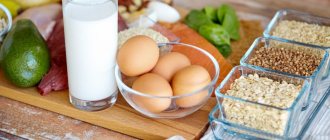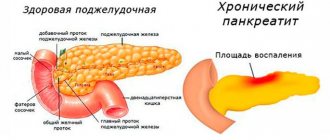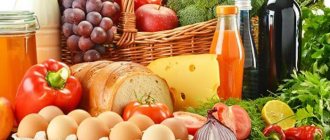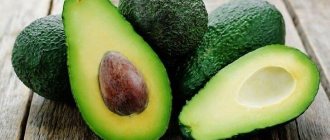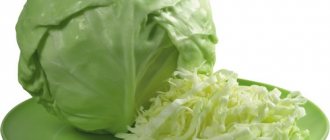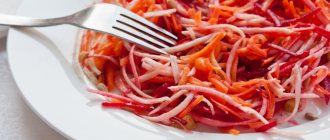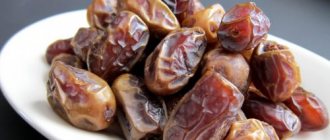Pancreatitis is an inflammation of the pancreas tissue. The patient often feels sharp pains that intensify and become unbearable after eating food that is difficult to digest. Pancreatitis is dangerous primarily due to the possibility of developing pancreatic necrosis. This disease very often leads to death in the absence of timely medical care. The article describes the principles of the diet: what you can eat and what you can’t. Pancreatitis can be reduced in its manifestations and stable remission can be achieved - but only with proper nutrition.
Nutrition for pancreatitis
The pancreas is an organ that reacts sensitively to even the tiniest doses of nutrients received from food. Ethyl alcohol is especially toxic to it. Even very small doses of this poison, which are contained in a 0.5 can of beer, can provoke an attack of exacerbation of pancreatitis. Almost all people with chronic alcoholism suffer from girdle pain in the abdominal area, characteristic of pancreatitis.
In order to stop an attack, it is not enough to take painkillers and fermented preparations. It is very important to adhere to proper nutrition according to medical table No. 5.
Types of hepatitis
The liver and pancreas do not really like fresh yeast baked goods
Hepatitis can have a different nature. It is usually caused by viral and toxic-allergic factors. A person can be given different diagnoses (hepatitis A, C, B); this disease takes on acute and chronic course. How to recognize acute hepatitis:
- Prolonged jaundice;
- Enlarged liver;
- Discolored feces;
- Darker urine;
- Slow reaction;
- Apathetic states.
Children may experience nosebleeds and rashes appear on the skin. In severe cases, everything starts the same, but over time the patient’s condition becomes worse, and the symptoms become stronger and more obvious. Hepatitis B is especially dangerous - severe types of the disease can provoke the development of liver necrosis. Acute hepatitis often develops into a chronic form.
It is fraught with danger: the disease proceeds unnoticed, the person does not feel acute pain, he is simply accompanied by persistent fatigue. Sometimes attacks of nausea that occur do not cause suspicion either. The chronic form of hepatitis is fraught with danger: it can develop into a more dangerous condition: cirrhosis of the liver or cancer.
A patient suffering from liver disease is prescribed medications and a gentle diet, which is designed to relieve the load on the diseased organ.
List of prohibited foods for pancreatitis
Foods and drinks that are strictly prohibited both during exacerbation of pancreatitis and during its chronic course:
- any alcoholic drinks;
- fatty meat - pork, lamb - and broths from it;
- fatty cottage cheese, milk, cheeses, fermented baked milk, ayran;
- any fried foods;
- dishes in which food is cut into large pieces - pilaf, stew, steak;
- fatty fish varieties are all names from the salmon family;
- chicken egg yolks;
- some citrus fruits, sour berries - everything is individual here, fruits can either provoke an exacerbation or not.
What can people with pancreatitis eat?
It is very important that food does not irritate the walls of the stomach and does not provoke excessive production of gastric juice and enzymes. To do this, you should eat the most lean, thoroughly chopped food.
- Among baked goods, preference should be given to lean bread, as well as products made from whole grain flour.
- Supermarkets have food sections for people on a diet - there you can choose special bread made from rye flour, which is guaranteed not to cause an attack.
- You can eat any dairy products that contain less than 5% fat. It is better to choose homemade cheeses, according to the same principle - with a minimum percentage of fat content, not too salty and not spicy.
- You can use any vegetables, boiled or steamed. Before eating, it is advisable to thoroughly grind them on a grater or in a blender.
- You can eat fruits, but it is better not raw, but baked, or at least first grind them in a blender so that large pieces do not end up in the stomach. Berries should be chosen that are sweet, soft, and not sour.
- Porridges made from any cereals and legumes - buckwheat, rice, chickpeas, pearl barley, oatmeal - are advisable for consumption both during the period of exacerbation of pancreatitis and during the period of remission. To be sure that the porridge will not cause an attack, you can first try a spoon or two. But most often, porridges are well tolerated, as are vegetable soups with water.
Basic principles of the diet
In order to reduce the load on the pancreas, it is recommended to remove from the regular diet all foods that lead to an increase in the functioning of the organ. These include:
- Alcohol.
- Fat.
- Fried.
- Spicy.
- Very salty.
- Smoked.
- Confectionery with creams.
- Fresh bakery.
- Cocoa.
- Chocolate.
- Strong coffee and black tea.
- Sour fruits.
It is necessary to note that legumes, cabbage and millet are contraindicated. Eating these products may make the condition worse. Since with pancreatitis the amount of enzymes that iron secretes is not enough to digest these products, they begin to rot in the large intestine and cause bloating. This, in turn, can cause re-inflammation.
Rules for preparing food for patients with pancreatitis
Any dishes should be prepared according to the following principles:
- Avoid large pieces of meat, vegetables, and fruits.
- Try to grate the ingredients of salads or main courses as finely as possible.
- Use a minimum of salt and spices, herbs.
- The leaner the food tastes, the less likely it is that an exacerbation will occur.
- You should not wash down your food with hot tea or coffee; in extreme cases, you can wash it down with low-fat kefir at room temperature.
- You should not cook first courses with broth; the best choice is vegetable soup with water.
- You should not eat excessively cold or hot foods and dishes - this is almost guaranteed to provoke an attack of pancreatitis. It is optimal for the food to be at room temperature.
Combination of BZHU and calorie counting
On day 5, the diet should be compiled in such a way that the total number of calories does not exceed 850. The menu is distributed as follows:
- carbohydrate foods – 310 g;
- proteins – 65 g;
- fatty foods – 22 g.
Food must be thoroughly pureed. You should focus on baby food. First, the product is crushed in a blender. Then, if necessary, it is ground additionally, manually, using a strainer. Salt is strictly prohibited.
After the 14-day period, the menu should be distributed as follows:
- carbohydrates – 460 g;
- protein food – 110 g;
- fats – 45 g.
After the alarming symptoms disappear, you are allowed to cook vegetable soups. You can also prepare fish and chicken soups.
Chicken soup with vegetables
The recipe for vegetable soup for pancreatitis is simple and healthy. Preparing this first dish will not take much time - about half an hour will be enough. Instead of bread for the first course, you can use homemade croutons or diet bread. To ensure that you avoid an attack, you should not eat this delicious dietary soup too hot. It is optimal for it to cool to room temperature.
You will need the following ingredients:
- 1 PC. chicken fillet;
- 1 peeled large potato;
- 1 medium sized carrot, peeled;
- 1 small onion, peeled;
- a couple of sprigs of dill and the same amount of parsley.
The basic rule is no broth! The recipe for vegetable soup for pancreatitis does not involve boiling bones or broth. One fillet should be chopped into small pieces about a centimeter in size. Pre-boil in salted water. Then pre-boil all the vegetables, which should be cut into thin strips.
Then measure out a liter of clean water, salt it to taste, bring to a boil and immerse all the prepared ingredients there. Add finely chopped greens. Cook over low heat for ten minutes. You will be surprised, but the result will be a quite rich and aromatic soup, no worse in taste than the chicken bone soups we are all familiar with.
Cabbage vegetable soup for pancreatitis
The recipe differs in the content of different varieties of cabbage in the broth. This vegetable is useful for pancreatitis, as it does not cause exacerbation. It is only important to boil the shredded cabbage well - otherwise it will be difficult for the stomach to digest it and the patient may be bothered by bloating and flatulence.
You will need the following ingredients:
- broccoli, pre-washed and finely chopped - about 400 grams;
- young white cabbage, chopped into thin strips or grated on a Korean grater - about 200 grams;
- cauliflower - about 400 grams;
- a couple of medium-sized peeled potatoes, cut into cubes;
- one carrot, grated on a fine grater;
- a sprig of dill and parsley to add flavor to the broccoli soup.
Place about one and a half liters of water in a saucepan, bring to a boil and add salt to taste. Add all ingredients and cook over medium heat for 25-30 minutes. Readiness to monitor the condition of the cabbage - it should be completely soft and not crunchy.
The recipe for vegetable soup for pancreatitis with cabbage is distinguished by its simplicity and at the same time sophistication. A variety of cabbage types and carrots make the soup bright and appetizing. Rich vegetable broth is very satisfying and will distract the patient from the feeling of hunger for a long time.
Soup recipe for pancreatitis during exacerbation
This is a rather ascetic option - it is ideal during a period of exacerbation, when girdle pain prevents you from doing everyday activities, and hunger only aggravates the situation. The recipe for dietary vegetable puree soup for pancreatitis has saved more than once every patient who is familiar with such pain firsthand.
Ingredients needed:
- a couple of medium-sized potatoes;
- half of one chicken breast (pre-boiled);
- half a carrot;
- a little pre-boiled chickpeas - about two hundred grams.
Take a liter of water into a saucepan, immerse vegetables in it, bring to a boil and boil until tender. Five minutes before turning off the heat, place the breast and chickpeas in the pan. Pour everything into a blender and grind until pureed.
You can add a handful of grated cheese - you get vegetable soup with cheese. During an exacerbation period, you should choose only lean varieties of cheese or completely avoid adding it to puree soup for a while.
The finished dish should be eaten only when it has cooled to room temperature or is lukewarm.
Secrets of preparing aromatic milk soups for people with pancreatitis
Patients on a diet often want to treat themselves to an unusual recipe for first courses. And they really miss desserts. Soup with processed cheese is just such an option for an unusual first course. The first portion should not be cooked too much, because you may not like the taste. It is very unique and largely depends on the quality of the processed cheese used. Sometimes it can be pure creamy, and sometimes it can give off an unpleasant chemical scent.
Ingredients:
- one good quality creamy processed cheese;
- a piece of chicken fillet 200-220 grams, pre-boiled and finely chopped;
- a couple of potatoes, cut into cubes;
- one carrot, grated on a fine grater;
- a sprig of dill and parsley for flavor.
Place a liter of water in a saucepan and add salt to taste. Immerse vegetables in it, bring to a boil and boil until tender. Five to seven minutes before turning off the heat, put chicken and cheese into the pan and mix thoroughly. The cheese will begin to spread before your eyes and very soon, in two to three minutes, will dissolve completely. Soup with processed cheese is also called creamy or milky. It turns out aromatic and satisfying.
Beetroot soup for patients with pancreatitis
This is a delicious recipe for a simple vegetable soup that is suitable for all people with diseases of the gastrointestinal tract. Its highlight is its red color and beetroot flavor.
For a liter of water you will need the following ingredients:
- one small beet, grated on a fine grater;
- one medium sized potato;
- a piece of lean veal - about 150 grams;
- medium sized carrots;
- medium sized onion.
Bring water to a boil and immerse all the vegetables in it, after grating them on a fine grater. The beets will immediately give the soup a rich purple hue. Boil the vegetables over medium heat for about fifteen minutes, add finely chopped veal. Don't forget to salt the soup to taste.
Possible harms of drinking smoothies
Despite the enrichment with useful substances, smoothies should not be drunk in excessive quantities. A healthy person needs 1-2 glasses of this drink per day. Exceeding this dosage may lead to:
- development of hypervitaminosis;
- irritation of the digestive organs;
- dizziness.
It should also be borne in mind that such a drink cannot replace a full meal. Consuming the product instead of lunch or breakfast or dinner will not provide a person with the necessary energy supply.
Most smoothies, especially fruit and berry smoothies, and cabbage smoothies are enriched with organic acids and fiber. Consumption of them in excessive quantities or during exacerbation of diseases of the gastrointestinal tract can lead to the appearance of dyspeptic symptoms:
- flatulence;
- gastrointestinal colic;
- bloating;
- increased gas formation;
- stool disorder.
Organic acids increase the activity of digestive enzymes; in diseases of the gastrointestinal tract, they irritate their mucous membranes, and coarse fiber injures the inflamed tissues of the digestive tract. For these reasons, such a drink should absolutely not be taken on an empty stomach.
Restrictions and contraindications
Sugary smoothies can increase blood glucose levels. Therefore, their use in diabetes mellitus is strictly limited.
It should also be taken into account that a person may have a personal intolerance to a particular product. Its inclusion in the drink will cause the development of allergic reactions in the form of skin rash, itching, redness, shortness of breath, even anaphylactic shock.
Drinks with a diuretic effect are contraindicated if there are stones in the kidneys or bladder. They can cause the movement of stones, which will lead to severe pain and deterioration of the patient’s well-being.
Thus, smoothies are contraindicated if:
- Intolerance to the components of the drink.
- Acute diseases of the digestive system.
- Diabetes mellitus (regarding sweet mixtures).
- Breastfeeding.
It is very important to use natural, high-quality products when preparing drinks. Since vegetables, fruits, berries, saturated with pesticides and chemicals will only cause harm to the body and can cause poisoning.
Sweet banana-curd soufflé
Almost all patients with pancreatitis lack sweets. Here is a simple recipe for curd soufflé that will not cause aggravation. The following ingredients will be required:
- a pack of low-fat cottage cheese;
- one banana;
- half a glass of skim milk;
- a teaspoon of powdered sugar.
Place all ingredients in a blender and blend until an airy soufflé is formed. Remember: you cannot eat this dessert cold! It, like all other dishes, should be at room temperature.
About mushrooms
Mushrooms are a unique plant organism, classified in botany as a separate kingdom. The quantitative composition of nutrients (proteins, fats, carbohydrates) and energy value vary depending on the type of mushroom. In general, this is a low-calorie product containing fats, a lot of proteins, and complex carbohydrates (in particular, fiber). The protein component provides the mushroom composition with a whole complex of essential amino acids.
Reference! The calorie content of dried mushrooms, in comparison with a fresh product, increases on average 8–9 times.
Vitamin and mineral composition
| Minerals | Vitamins |
| copper | retinol (A) |
| zinc | ascorbic acid (C) |
| manganese | Niacin (B3 or PP) |
| potassium | ergocalciferol (D2) |
| calcium | thiamine (B1) |
| iron | riboflavin (B2) |
| phosphorus |
For a healthy body, eating mushrooms brings unconditional benefits. Due to the abundant amount of proteins, fiber, vitamins and minerals in their composition, mushrooms are included in numerous medicinal diets. Low energy value is the basis for the presence of the product in dietary nutrition aimed at weight loss.
Mushrooms have exceptional taste. In the culinary arsenal you can find fried, boiled, baked, salted and pickled mushroom variations. They are used to prepare first and second courses, fillings for pancakes and pies, and gourmet snacks.
Baked Apple with Cinnamon
If you have pancreatitis, you can only eat sweet apples, since green, sour varieties can provoke an attack of the disease. There is a simple recipe for a safe dessert that will fill you up and satisfy those who love sweets.
You should take several large sweet red apples, cut each one in half and remove the core with a knife. Sprinkle with powdered sugar (you can do without it) and just a little cinnamon. A few grams will not harm your health, but will create a unique aroma. It should be noted that if the patient is currently experiencing an exacerbation, it is better to refrain from eating apples with cinnamon.
Place apples on a baking sheet on parchment. Bake at a temperature of about 180 degrees for ten minutes.
THURSDAY
Breakfast: cheesecakes without flour
Lunch: rice soup with meatballs; zucchini stuffed with vegetables
Afternoon snack: smoothie with strawberries
Dinner: chicken soufflé with steamed carrots in a slow cooker
Nutritionist's comment:In the smoothie recipe, I recommend slightly reducing the amount of sugar; there should be no more than 1 teaspoon per serving; if this seems too little to you, you can use sweeteners. |
